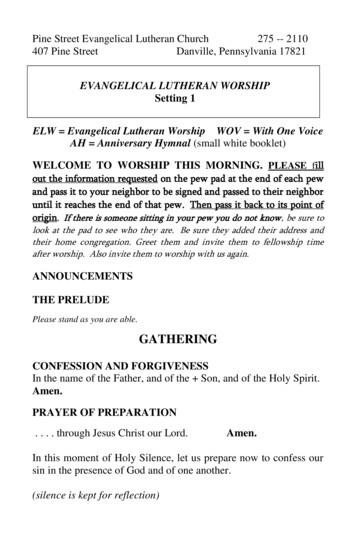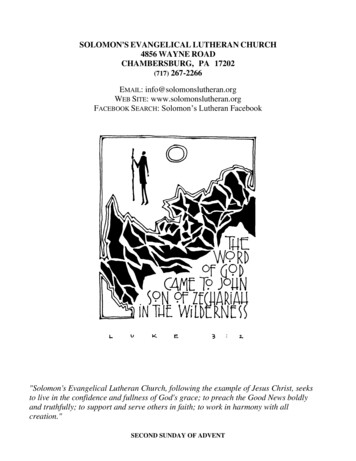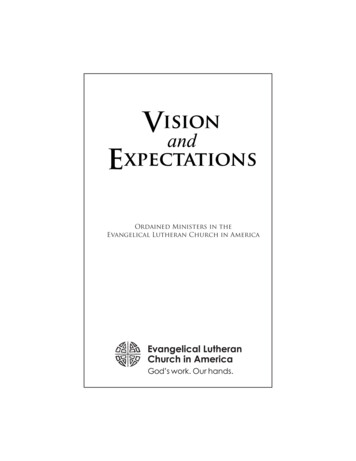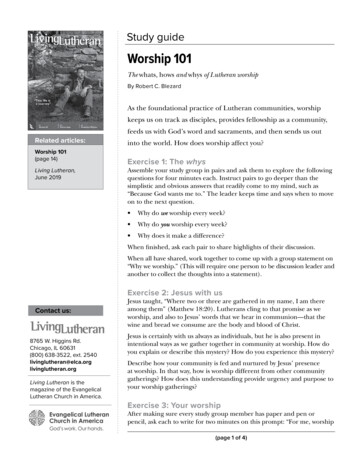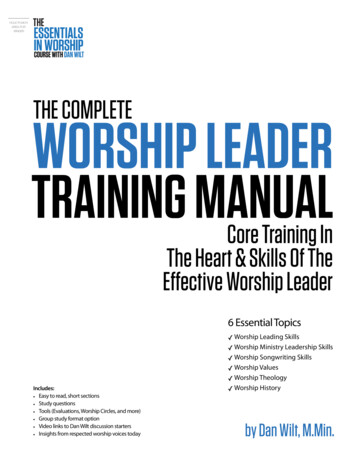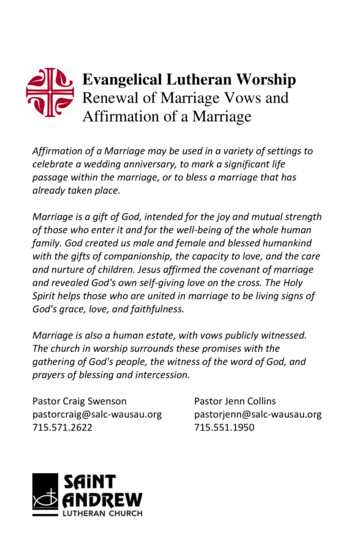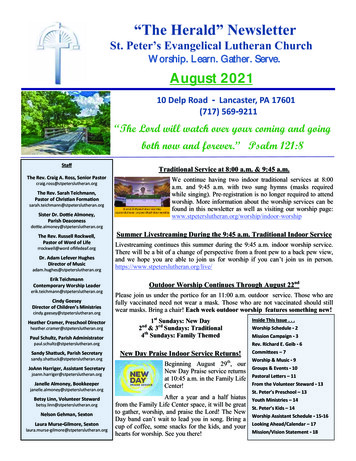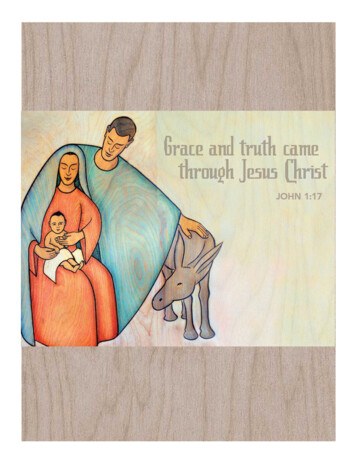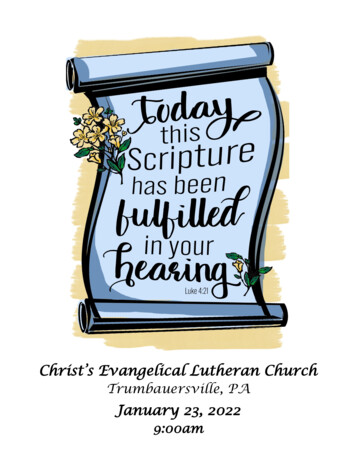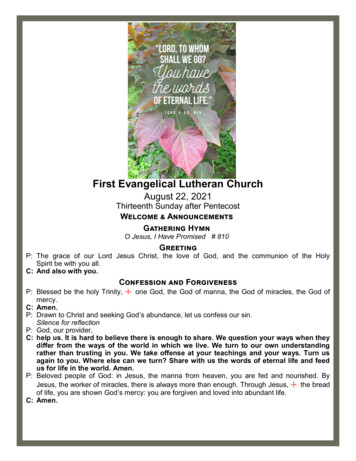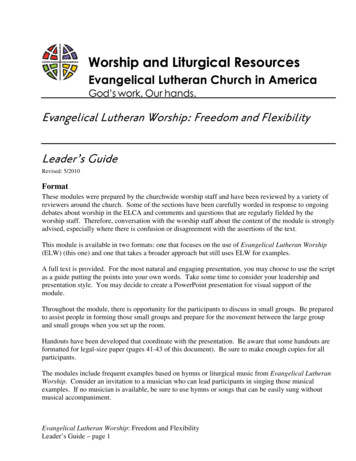
Transcription
Evangelical Lutheran Worship:Worship: Freedom and FlexibilityLeader’s GuideRevised: 5/2010FormatThese modules were prepared by the churchwide worship staff and have been reviewed by a variety ofreviewers around the church. Some of the sections have been carefully worded in response to ongoingdebates about worship in the ELCA and comments and questions that are regularly fielded by theworship staff. Therefore, conversation with the worship staff about the content of the module is stronglyadvised, especially where there is confusion or disagreement with the assertions of the text.This module is available in two formats: one that focuses on the use of Evangelical Lutheran Worship(ELW) (this one) and one that takes a broader approach but still uses ELW for examples.A full text is provided. For the most natural and engaging presentation, you may choose to use the scriptas a guide putting the points into your own words. Take some time to consider your leadership andpresentation style. You may decide to create a PowerPoint presentation for visual support of themodule.Throughout the module, there is opportunity for the participants to discuss in small groups. Be preparedto assist people in forming those small groups and prepare for the movement between the large groupand small groups when you set up the room.Handouts have been developed that coordinate with the presentation. Be aware that some handouts areformatted for legal-size paper (pages 41-43 of this document). Be sure to make enough copies for allparticipants.The modules include frequent examples based on hymns or liturgical music from Evangelical LutheranWorship. Consider an invitation to a musician who can lead participants in singing those musicalexamples. If no musician is available, be sure to use hymns or songs that can be easily sung withoutmusical accompaniment.Evangelical Lutheran Worship: Freedom and FlexibilityLeader’s Guide – page 1
Physical arrangementThe best arrangement will be a meeting space with moveable seating that facilitates the formation ofsmall groups for conversation. Ideally the room will not feel cramped nor overly large. A comfortabletemperature and ventilation are helpful to aid concentration and participation.If projection will be used, make sure that the projection can be seen by all participants.Group discussionGroup discussions work best in small groups of 4 to 8 people. It may be beneficial for the same group tomeet together throughout the event. If there are people from multiple congregations, encourage peopleto be in conversation with people from different congregations. You may decide to “count off” by thenumber of groups and then have like numbers gather together.Be prepared to facilitate times of “reporting” from the small groups. Some groups may needencouragement to stay on task and focus their comments on the question at hand.Fielding QuestionsBefore leading the module, take some time to reflect about how you will respond to questions from theparticipants. Questions about decisions made in the development of Evangelical Lutheran Worship arebest directed to the churchwide worship staff at worship@elca.org. Feel free to provide that e-mailaddress during your presentation.Be prepared to stop unhelpful conversations in a way that validates diversity and redirects back to thetopic at hand. A good strategy for responding to ideas from the participants is to encourage otherparticipants to comment, balancing both the positive aspects and challenges presented by the idea.Resource ReviewBefore facilitating this module, it may be helpful to review the following resources:The Use of the Means of Grace: A Statement on the Practice of Word and Sacrament (1997)available online at ng Worship 2: Principles for Worship (2002) available online rning-Center/Principles-of-Worship.aspx orfor 15.00 at www.augsburgfortress.com. The Use of the Means of Grace is an appendix in thisvolume.Central Things: Worship in Word and Sacrament by Gordon Lathrop (2005). Available as partof the Worship Matters series for 9.99 at www.augsburgfortress.com.Evangelical Lutheran Worship: Freedom and FlexibilityLeader’s Guide – page 2
The Lutheran World Federation’s Nairobi Statement on Worship and Culture (1996). Downloadat ing-Center/LWF-NairobiStatement.aspxUsing Evangelical Lutheran Worship: The Sunday Assembly by Gordon Lathrop and LorraineBrugh (Augsburg Fortress, 2008). In particular, it may be helpful to read the opening foundationchapters.“Notes on the Services” in Evangelical Lutheran Worship: Leaders Desk Edition (2006), pages9-52.Evangelical Lutheran WorshipThis module often refers to Evangelical Lutheran Worship (ELW). Participants should be urged tobring copies of ELW to the module. Alternatively, copies of ELW may be made available for use by theparticipants.Fully Anticipated Questions/Concerns from the Participants“Traditional,” “Contemporary,” and “Blended” Worship LabelsAlthough these terms are commonly used, they can be divisive and have varying definitions. Allworship contains a mixture of elements that are both ancient and timely making all worship“traditional,” “contemporary,” and “blended” to varying degrees. Participants will most likely comewith emotion-charged stories from their experience often centered in these terms. Therefore, it isstrongly suggested that these terms be avoided. The module intentionally uses the language of theintroduction to ELW which is based on our Lutheran confessional language: unity but not uniformity.As much as possible, guide the conversation toward uncovering the unifying elements that supportChristian worship but that may be expressed differently in each unique context.It cannot be emphasized enough that this module does not offer simple answers to complex worshipquestions. The emphasis is not on sharing the next “big thing” in worship. Rather, the emphasis is onstudying one’s own congregational context, knowing the essentials, becoming familiar with theresources, and trying out something new in your community for the sake of ongoing worship renewal.The Location of “the Peace”Some may note that the location of the “peace” in the liturgy moved from the beginning of the “Meal” tothe end of the “Word.” The sharing of Christ’s peace in the liturgy is best understood as a transitionpoint in the liturgy between the “Word” and the “Meal.” The sharing of the peace is both in preparationfor the community’s feast at Communion and in response to the gospel proclaimed recognizing Christ’speace in the midst of the community.Ecumenical Worship TextsThe ecumenical worship texts commonly used in Lutheran worship include the Kyrie Eleison, Gloria inExcelsis, Apostles’ Creed, Nicene Creed, Sursum Corda (Great Thanksgiving dialogue), Sanctus andBenedictus (Holy, Holy, Holy), Agnus Dei (Lamb of God), Gloria Patri, Benedictus (Song ofZechariah), Magnificat, and Nunc Dimittis (Song of Simeon).Evangelical Lutheran Worship: Freedom and FlexibilityLeader’s Guide – page 3
These texts underwent their most recent language update in 1988 by the English Language LiturgicalConsultation (www.englishtexts.org). The ELCA reveals its commitment to the visible unity of thewhole Christian church by using these texts in ELW and other worship resources. For background onthese texts and their translation issues, see the document “Praying Together” which is out of print butavailable as a pdf at http://www.englishtexts.org/text.html.QuestionsIf you have questions about the content or presentation of this module, contact The Rev. Jennifer PhelpsOllikainen, Associate for Worship Resources, 773.380.2577, Jennifer.Ollikainen@elca.org.Presentation Outline(Opening introductions and worship)IntroductionThe Things We Hold In CommonPatternsWordsActionsSongsFreedom and Flexibility Break Patterns, Words, Actions and Songs in Gathering, Word, Meal, and SendingGatheringWordMealSendingOverarching ConsiderationsConclusion(Closing devotion)Evangelical Lutheran Worship: Freedom and FlexibilityLeader’s Guide – page 4
Evangelical LutheranLutheran Worship:Freedom and FlexibilityPresentation TextIntroductionIn the next three hours, we will explore worship.A lot is at stake:In worship, we are drawn by the Holy Spirit into the very presence of God.In worship, God is predictably present.In worship, we are shaped and formed by Jesus Christ, our savior.Worship deserves careful and intentional planningso that whatever we do, we don’t get in the way of what is at stake.Today, we will talk briefly about what is at the core of worship:the essentials,the central elements,that which makes Christian worship, worship.Then, once we have a framework of central elements,we will explore what it means to exercise our freedom and flexibilityin small ways, and, perhaps, in more daring ways.Imagine any given Sunday.Christians are gathered together by the Holy Spirit for worship.You might format this in a way so different participants could read the followingexamples highlighting the different people/different context assumptionsIn one setting,The gathering time begins with seven rings of the steeple bell and the people of Godstand, turn toward the entrance of the church where the processional cross begins itsjourney down the aisle and the organ music swells with the first hymn.Evangelical Lutheran Worship: Freedom and FlexibilityPresentation Text – page 5
In another setting,The gathering time begins as the worship leaders invite the people of God into energizedsinging songs of praise led by the praise team that includes guitars, bass, vocalists and adrum set.In still another setting,The people of God gather informally around a baptismal font located just outside theentrance of the worship space where they will remember their baptism with water andprayer before entering the worship space and taking their seats.In another setting,The people of God gather in silence, kneeling in reflective prayer before being gatheredby the worship leader with “The grace of the Lord Jesus Christ, the love of God, and thecommunion of the Holy Spirit be with you all” and then the prayer of the day signalingthat worship has begun.All of these communities of faith – regardless of their particular worship practice,all of them are gathered with the church across time and spaceby one Gospel of Jesus Christ.Or, if we come at it from another direction:The Christian community values the identity of each individual by virtue of their baptismover any other trait as described in Galatians 3:27-28:“As many of you as were baptized into Christ have clothed yourselves withChrist. There is no longer Jew or Greek, there is no longer slave or free,there is no longer male and female; for all of you are one in Christ Jesus.”(NRSV)How is that brought to expression in worship by the community?In one setting,worship leaders wear long, flowing, white garmentsto cover class and gender identifying street clothesThese albs identify the wearer primarily as a baptized child of God.In another setting,all are greeted as they come into worship not with names,but with “brother” and “sister.”These family titles highlight the relatedness of each member of God’s family.Evangelical Lutheran Worship: Freedom and FlexibilityPresentation Text – page 6
In still another setting,the new large baptismal font with flowing wateris located immediately inside the entrance of the churchso all have to pass by the water before entering the worship spacethereby gathering the community together in baptism.Or imagine how different settings might recallhow their Christian life is shaped by the public proclamation of the Bible.In one setting,the Bible readingsare surrounded by song and joyful acclamationwhere people stand and sing and dance and clap.In another setting,the Bible is brought into the center of the worship spacewith great solemnity and ceremony and read in the midst of those who are gathered.In still another setting,the biblical symbols and stories are illuminated by artworkseasonally on banners,permanently in the stained glass windowsand projected onto a screen according to the reading for the day.Our primary question for today is:How can we exercise freedom and flexibility around the central core elements of ourChristian worship?That is,How do we intentionally and responsibly shapeworship that welcomes everyone who is hungry for God’s grace?How do we live out the fact that worship is not about personal preference?How do we intentionally and responsibly shapeworship that brings to expression thejoys and the challenges of the good news of Jesus Christ?We are not here to find that one worship secret that will absolutely work for everyone.Nor will there be a fail-safe prescription for creativity in worship.Rather, today we are deepening our thought about worshipin order to make appropriate decisions about what we do in worship.Evangelical Lutheran Worship: Freedom and FlexibilityPresentation Text – page 7
The things we hold in commonBegin with a personal story about your experience of feeling at home in the centralelements of worship in a worshiping assembly that was new to you.(I don’t know about you, but I have moved around a lot in my lifeI’ve moved into communities where I did not know anyone.I was taught to find a safe place in the community of the church.And so each new place I went,I sought out the local Lutheran church.Attending worship,I always felt at home in the predictable shape of worship:prayers, songs, Bible readings, the meal, the sending.No matter where I went,I was instantly part of the community as I responded to the phrases I knew so well.The Lord be with you. And also with you.Go in peace. Serve the Lord. Thanks be to God!)If we are to be about the flexibility and freedom of a worship resource,we begin with an underlying foundation and structure.By definition, flexibility assumes a starting place,a place from which to reach, and stretch, and adapt.If you were going to bake a cake,You would first learn the basic vanilla cake recipeto learn how flour, sugar, eggs, and baking soda work together.Then, based on the foundational recipeyou might get creative adding flavorings and fillings and more.When you need a cake, you would also then gauge how fancy a cake you need –Something simple – or something elaborately decorated.For so long in our worship life as Lutheranswe have considered our book as containing all there is.If we wanted to do something different,we jumped out of the containing walls of one bookto something completely different.Now, we talk about a core.Evangelical Lutheran Worship: Freedom and FlexibilityPresentation Text – page 8
That is, we tear down those wallsand reach and stretch from the center, the core.Some may be most comfortable really close to that coreothers may tolerate a lot of stretch.The introduction of Evangelical Lutheran Worship helps us get to the common things:“Worship takes place in particular assemblies within particular contexts. Yetevery assembly gathered by the Holy Spirit for worship is connected to thewhole church. Worship unites the people of God in one time and place withthe people of God in every time and place. We use patterns, words,actions, and songs handed down through the ages to express this unityand continuity. . .” (ELW page 6)The patterns, words, actions and songs that we hold in commonexpress our unity throughout the church todayour continuity with the church that has come beforeAnd the church that is yet to be.These common things are the things that point outthat this gathering of people is Christian worshipand not people gathered fora show, or a sporting event, or a town meeting, or a class, or something else.Patterns, Words, Actions, Song:Turn to pages 92 and 93 of ELW where the pattern for Holy Communion is illustrated.Four main headings shape this pattern,GatheringWordMealSendingEach heading is described in bold, italicized statements that form a basic pattern ofworship:The Holy Spirit calls us together as the people of God.God speaks to us in scripture reading, preaching, and song.God feeds us with the presence of Jesus Christ.God blesses us and sends us in mission to the world.Evangelical Lutheran Worship: Freedom and FlexibilityPresentation Text – page 9
(A visual representation that captures the movement of the order of servant would looklike:WordMealGatheringSendingThe gathering leading into the “twin peaks” of the Word and Meal and then leading outthrough the sending.)The order can be seen to follow a biblical pattern, a gospel pattern.Think about the gospel narratives:At the start, Jesus is baptized.Then there are stories upon stories of God’s work in Jesus ChristWord made flesh coming to expression.Then there is the meal, the passion, and the resurrection.And finally there is a command to the disciples to “go and tell”disciples who have been transformedby their interaction with the risen Christ.For centuries, Christians have followed this gospel pattern in their gatherings.Entering the Christian community through the waters of baptism,they are formed by the Biblical witnesspublicly proclaiming those stories of God’s work in the worldand responding to that witness in the here and now.They are fed at the table of the Lordand so nourished are sent out of the assemblyto serve and proclaim the very good news they know to be true.And then they are drawn back to recall the beginning again –To encounter the living Christ and to go and tell.Only to be drawn back again together in worship.And so today, we continue this pattern in worshipeven when the pattern is uniquely adorned from place to place.ELW introduction to Holy Communion states:“The basic pattern of this service – gathering, word, meal, sending – is a structure thatallows for freedom and flexibility. . . The whole people of God are joined by the samegifts of grace, for the sake of the mission of the gospel, into the life of the one triuneGod.”Evangelical Lutheran Worship: Freedom and FlexibilityPresentation Text – page 10
We will focus on the Holy Communion pattern today –but keep in mind that the church has handed down a number of patternsthat can be examined in Evangelical Lutheran Worship.We don’t have time today, but at some point,I commend to you to read through these patterns in ELW.Patterns for Baptism, Lent and the Three Days,Life passages (Healing, Marriage, Funeral), and Daily Prayer (Morning, Evening,Night, and Responsive Prayer).Each pattern serves as a guide, that basic recipe that can be fleshed out or kept simpledepending on the setting and the situation.Patterns, Words, Actions, Song:There is a unity in the words and languagethat we use when the Christian community gathers together.Primarily, the words of Scripture shape the gathering and its language.The Word of God as it is written in the Bible is proclaimedany time the Christian assembly is gathered.The Christian assembly is a place where that word of God finds a place to be proclaimed.And the word of God shapes the assembly as it gathers.Think of the difference of two actions and the words that accompany them:While shaking hands with someone say: “Good morning.” Then shake the hand ofanother saying, “The peace of Christ be with you.”What is the difference between the two?(You may choose to encourage responses from the group. Anticipate that someone maystate that “good morning” is thought to be really special. Also anticipate thatparticipants may have difficulty succinctly articulating why the scriptural referencemakes something different happen.)Using the words of scripture and recalling the words of Jesus Christprofoundly shapes an interaction - a simple gesturewith the fullness of the word of God.Just as Jesus came to the disciples in that locked room described in John 20:21,so Jesus is present in this moment in worship.Evangelical Lutheran Worship: Freedom and FlexibilityPresentation Text – page 11
This simple handshake with those words from a scripturalmake this not just between you and me –but about something more.With those words – the peace we share is not ours – but Christ’s.With those words – we are the presence of Christ to one another.With those words – we are not just a bunch of folk – but the community of Christ.The words we use in worship profoundly shape who we areboth as individuals and as the whole community of Christ.Words are an essential part of our lives as human beings –spoken, written, sung, or enactedThey are also essential in our worshipcommunicating the stories and reality of God’s love for us in Jesus Christ anddescribing the mission to which we are called.Repetition of the language that shapes ustransforms reality and helps us understand who we are.(How many of your lives been shaped by the repetition of a word or phrase? Whichrepeated phrases? For example, my 5 year old will not let me leave his bedroom at nightwithout saying “‘Night ‘Night, sleep tight. I love you.”)And on the other hand,fresh words have the power to help us see something new.Words can point us to a new point in the story, a new perspective of gracewith a fresh turn of phrase.For example, seasonal changes in the language of the confession and absolutioncan help us to understand our sin and Christ’s forgiveness in a different way.So there is a balance at work.On the one hand,words that are repeated shape us – they get into our bones.There is a gift in the liturgical language as we come to know it.And on the other hand,fresh language, things said in new ways,has the power to help us come to a fresh realization.Repetition and change are to be in balance.Evangelical Lutheran Worship: Freedom and FlexibilityPresentation Text – page 12
Patterns, Words, Actions, Song:Tell a story about when you recognized the actions in worship even when the words,patterns or language may have been different.(When I was in seminary,I went to Guyana, South America on a cross-cultural immersion trip.On that trip, we traveled far into the interior of the rain forestWhere electricity and plumbing were unpredictable at best.We were in the village of Kwa-Kwani on Sunday,And went to worship at the Lutheran church.Worship did not have a set starting time –Rather, in a gesture of profound hospitalitythat didn’t come easy to me, a clock-watcher,worship began when everyone arrived(Even if that was an hour later than we expected!)When worship began,I did not know exactly what was coming next,But I understood that this was worship based on the shape I knew –Prayer, The reading of scripture, the Lord’s Prayer, the eating of the meal.So much of this Christian worship was strange and newbut it was still clearly worship.)Christian worship encompasses a set of actions,actions that are oftentimes rooted in scriptureactions that through the history of the church have shaped who we are.As we think about actions,we are really thinking about how words are received by the assemblyand how the whole assembly is active in worship.When our bodies participate in the service,the assembly comes alive as the presence of Christ.Although they are not necessarily exclusively Christian actions,the actions have a character that proclaims something more than the action itselfin the Christian assembly at worship.Evangelical Lutheran Worship: Freedom and FlexibilityPresentation Text – page 13
Think of baptism,when you get down to it, baptism is a simple action of washing with water.We use common things for the washing that happens in Christian assembly –water, oil, light,But the simple action is transformed and proclaims something moretogether with the word of God.when done at the command of Jesus Christ.In worship, the action of washing is given meaningas baptism which gives forgiveness and new life in Christ.Although different settings may enact this washingin a large pool or a natural body of water or a small bowlThe action of washing is common.There are other actions that gather us together as Christians at worshipand communicate our unity in Jesus Christ.What other actions define us as a Christian assembly at worship? i.e. crossing self,kneeling, standing, eating, handshakes, anointing, clapping, dancing, etc.Patterns, Words, Actions, Song:So often we think of music in its multiple variations and its polarities:classical and popular, sacred and secular, country and folk (What else?)When we want to “change” something about worship –we often examine the music first.We change the hymns to praise songs,the accompaniment from organ to praise band.Music is so often a point of divergencethat we often overlook the commonalities.All people, all cultures share some kind of musical expression.As human beings, we hold song in common with one another.As human beings in relationship with God,music has been almost always been a vital part of Christian worship.Evangelical Lutheran Worship: Freedom and FlexibilityPresentation Text – page 14
For thousands of years,those who worship God have sung the psalmswhen they gathered together in worship.Christians carry on the presence of song in worshipsinging particular texts in particular ways throughout the years.Lutheran Christians, in particular, celebrate the presence of music in worship.In song, the assembly, as a whole proclaims the gospel.After the reading of scripture and preaching,in most Lutheran churches, the assembly then has its turn together.We join in the hymn of the day – a time to proclaim the word of God in song.In worship we believe that singing is participatoryeven when that belief is counter-cultural.When we gather for worship, we join our voices together to sing.We don’t simply listen to a performance,rather, something happens when we sing together as a group.We are invited to be a part of the people of God – not abstractly –but with body and breath and sound.Different communities will gravitate toward a different repertoire of songs of the faith,But, right now, we hold a single book in our hands.The fact that a variety of songs, hymns, and liturgical musiccan be found in one resource speaks to our unity.But this book cannot possibly contain every possibility for every community.It is core – but not self-contained.Freedom and flexibilityShare a story of something unique to a setting of worship that worked in the context butthat may not work in another time and place.(I once led worship at the close of a women’s retreat.The theme of the retreat was based on the story of the woman at the well in John 4.We used small river stones during the retreatTo symbolize and visualize the sin that weighed us down.So at the beginning of this closing worship service,We remembered our baptism – but in an unusual way.To symbolize the forgiveness and freedom we have in baptism,We dropped our stones in the fontEvangelical Lutheran Worship: Freedom and FlexibilityPresentation Text – page 15
After a thanksgiving for baptism that spoke of fountains of living water (from the John 4text)We were sprinkled with water and we sang Alleluia.It worked in that moment, at that situation But in other places, it might have simply seemed strange.)What “works” in worshipis different from setting to settingeven as we share the essentials elements.The introduction to Evangelical Lutheran Worshipis helpful in reminding us what is at stake.After its discussion about the unity we share in worship, the introduction says:“The Christian assembly also worships in the midst of an ever-changingworld. And because the worship that constitutes the church is also thefundamental expression of the mission of God in the world, worship isregularly renewed in order to be both responsible and responsive to theworld that the church is called to serve.” (ELW 6-7)That is, in worship, our freedom and flexibility has a central purpose:to be both responsible and responsiveto the world the church is called to serve.Worship is necessarily in relationship with the world-with the people who are inside the worship spaceand outside the worship space.Worship is an intersection point with the world.Worship speaks in the world in ways that can communicate the love of God.Being responsive to the world assumes that we know our world.It means that we examine and describe ourselves and our communitythat we listen to it, support it, and even sometimes critique it.Whatever our context,We tend to think of it as normal- the way that things are supposed to be.However, the church is so much broader than our individual contexts.The Gospel is for all – not just those in the pew at the moment.Evangelical Lutheran Worship: Freedom and FlexibilityPresentation Text – page 16
The Gospel pulls us out and sends us outside of our comfort zonesfor the sake of God’s love for the world.We need to be aware of our assumptions and our comfort zonesin order to be truly responsive to the whole community.Let’s take a few moments to really look into our own contexts.Reflection/discussion:In pairs, take turns describing the context of your church and community (pair withsomeone who is not from your congregation!) Think as descriptively as possibleand fairly broadly about the community within the walls of the church and outsideof the walls. What do the people look like? Do they all look the same? What aretheir ages? Where are they from in the world? What is the landscape?Socioeconomic status? Political status? Church backgrounds? And talk brieflyabout how all of that descriptive information shapes your usual worship.Being responsive and responsible is a balance.On the one hand, we are responsive to the world for the sake of the world.On the other hand, we are responsible to not be consumed by that world.So we need to be careful to be always reflecting aboutwhat we are doing, why we are doing it, and how we are doing it.For example,In some settings, worship is shapedto include silence, reflection, and l
Evangelical Lutheran Worship: Freedom and Flexibility Presentation Text – page 5 Evangelical Lutheran Worship: Freedom and Flexibility Presentation Text Introduction In the next three hours, we will explore worship. A lot is at stake: In worship, we are drawn by the Holy Spirit into the very presence of God. In worship, God is predictably .
